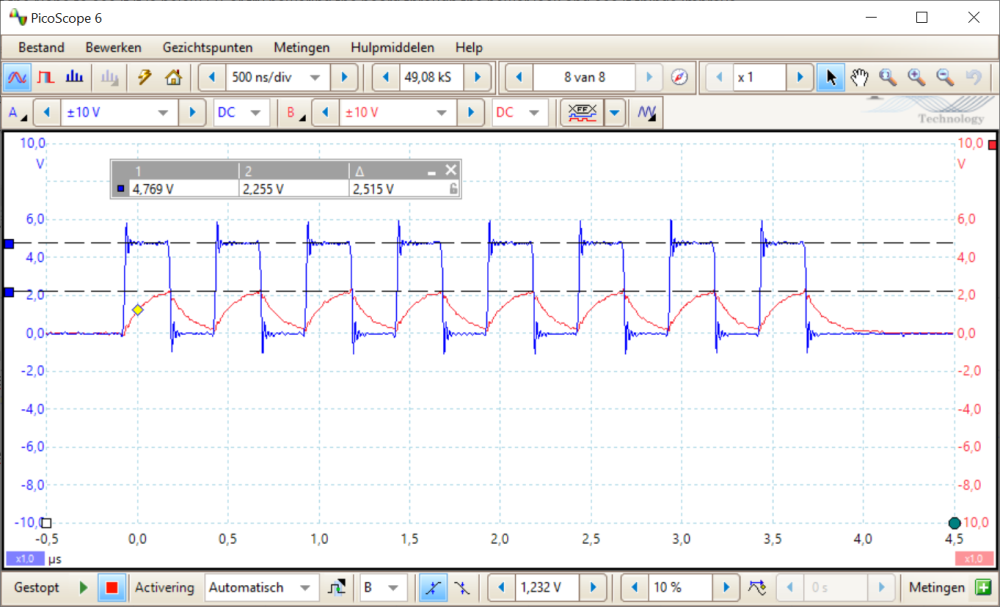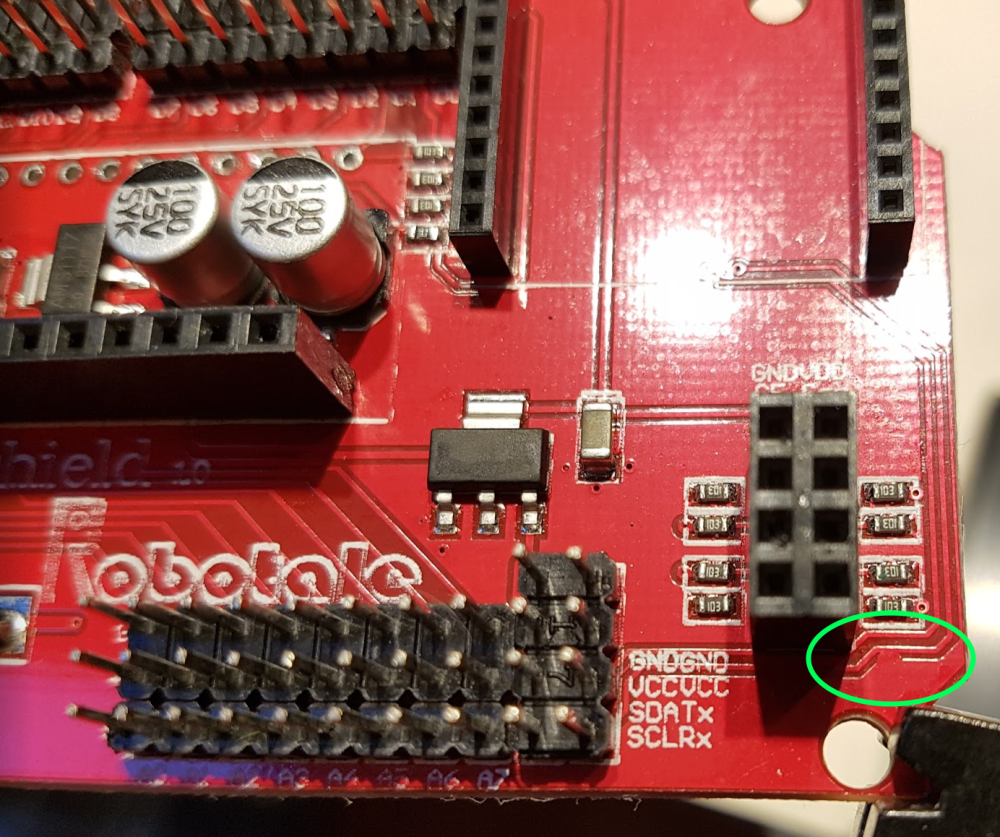CDEBYTE's new NRF24 modules are great! (and cheap)
-
@yveaux said in CDEBYTE's new NRF24 modules are great! (and cheap):
According to Nordic's datasheet this should be ok (minimum HIGH level input voltage is 0.7 * VDD, so 0.7 * 3.3V = 2.31V) as long as your Arduino is fed with 5V this should just work, but it is tricky IMHO.
My Nano came in and I did a quick test with one of my IO shield boards and a regular, unamplified clone nRF24.
This is a scope plot of the SCK (clock) signal:

It does work, but apparently only barely: The blue line is SCK coming from the Nano (at 4.77V) and the red one is the SCK as seen by the nRF (2.26V max, where nRF24 expects at least 2.31V according to the datasheet)
An amplified EByte E01-ML01DP5 and amplified, unshielded clone indeed do not work.
I see a few solutions to this ploblem (lowering the nRF24 VCC or changing the resistors on the voltage dividers) which I'll give a try and report back.
@yveaux said in CDEBYTE's new NRF24 modules are great! (and cheap):
I see a few solutions to this ploblem (lowering the nRF24 VCC or changing the resistors on the voltage dividers) which I'll give a try and report back.
Lowering the nRF24 VCC is not feasible as it will also impact the signals going to the ATMega below minimum levels.
I replaced 4 10k SMD resistors R5, R6, R7 & R8 by 4k7 types:

@รอเร-อ This patch makes both regular and amplified nRF24 modules work correctly! The IO levels to the nRF are raised to 3.3V at 5V Arduino supply.
Btw. I ordered 2 of these IO shields (red version, by 'Robotale' according to silkscreen) and the quality is horrible...
It's nearly impossible to push the Nano in the socket, it was full of (near) solder shorts, the silscreen is barely readable and one of the boards contained a short to GND on the RX line, making it impossible to program (geen circle):
-
@yveaux said in CDEBYTE's new NRF24 modules are great! (and cheap):
I see a few solutions to this ploblem (lowering the nRF24 VCC or changing the resistors on the voltage dividers) which I'll give a try and report back.
Lowering the nRF24 VCC is not feasible as it will also impact the signals going to the ATMega below minimum levels.
I replaced 4 10k SMD resistors R5, R6, R7 & R8 by 4k7 types:

@รอเร-อ This patch makes both regular and amplified nRF24 modules work correctly! The IO levels to the nRF are raised to 3.3V at 5V Arduino supply.
Btw. I ordered 2 of these IO shields (red version, by 'Robotale' according to silkscreen) and the quality is horrible...
It's nearly impossible to push the Nano in the socket, it was full of (near) solder shorts, the silscreen is barely readable and one of the boards contained a short to GND on the RX line, making it impossible to program (geen circle):
@yveaux said in CDEBYTE's new NRF24 modules are great! (and cheap):
This patch makes both regular and amplified nRF24 modules work correctly!
Dear @Yveaux
Thanks for all the work you've put into investigating this issue.
I have a different brand of the Nano IO Shield but the quality is equally very low. I guess I'll need to inspect them carefully before I use them. I guess I have 10 of them and I will try to apply the HW patch you've suggested but I'm not sure I'll be able to make it, I don't have any SMD resistors and they are to small to work with for me. I'll need to give it a try anyway.
Thanks again and merry christmas btw :santa:
-
@yveaux said in CDEBYTE's new NRF24 modules are great! (and cheap):
This patch makes both regular and amplified nRF24 modules work correctly!
Dear @Yveaux
Thanks for all the work you've put into investigating this issue.
I have a different brand of the Nano IO Shield but the quality is equally very low. I guess I'll need to inspect them carefully before I use them. I guess I have 10 of them and I will try to apply the HW patch you've suggested but I'm not sure I'll be able to make it, I don't have any SMD resistors and they are to small to work with for me. I'll need to give it a try anyway.
Thanks again and merry christmas btw :santa:
@รอเร-อ shorting the mentioned resistors (with eg a solder blob) will probably also work, but then you'll exceed the maximum 3.3v on the CE line for amplified modules. However, many people run amplified modules at 5v signal level without issues.
Merry Christmas to you too!
-
@รอเร-อ shorting the mentioned resistors (with eg a solder blob) will probably also work, but then you'll exceed the maximum 3.3v on the CE line for amplified modules. However, many people run amplified modules at 5v signal level without issues.
Merry Christmas to you too!
-
I've managed to replace the SMD resistors according to your suggested hack described above. It wasn't easy though. Anyway, it seems to work well. Thanks!!!
-
They are getting really expensive now.
Are there any good cheap modules to recommend now?
Perhaps the RobotDyn modules? They are $1,80, plus $1,80 for shipping. If you buy a few this can save some money. Has anyone tried this one?
